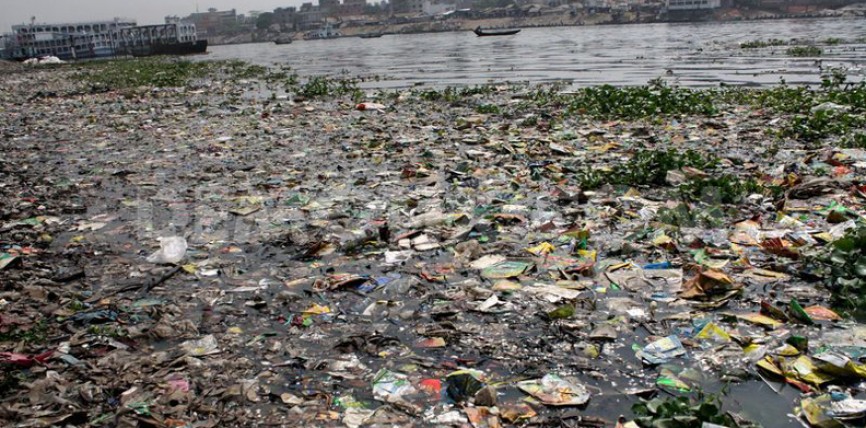The life of Dhaka is the Buriganga river. Now it is almost dead.
400 years ago Dhaka city was developed on the banks of Buriganga river. He lives in the life of Dhaka Buriganga. Buriganga has become a dead river in the last four decades after the independence of Bangladesh by grabbing tulle and pollution. There is no place anywhere in the river and it is being built every day. Reducing river widening, decreasing life flow It is said that in ancient times, a flow of the Ganges was mixed with the Bay of Bengal as Dhaleshwari. Over time, the direction of the flow is changed due to natural reasons. As a result, communication with the Ganges becomes separated. Later, the disconnected stream was known as Buriganga.

On June 1, 2011, a High Court verdict said that the water pollution of the Buriganga river reached such a level that this water can not be called water. The court feels that the health of the people of the country is harmed. The truth of the court is true. It is better to call it Buriganga water as it is no longer water, it is better to call it black oil. Because there is nothing for the elements that are supposed to be in the water. People walk on the nose with rubbish water bad odor Even after this people are bathing due to lack of awareness. Cleaning the chemical drum. In the hope of crossing the boat, the passenger crosses. People from some areas are working to clean up clothes, dishwashers, and pollute Buriganga's polluted water.
The dissolved oxygen in Buriganga water has decreased considerably. The quality of the water was damaged. Pranapuri Buriganga of the capital city of Dhaka is now the ruin of urban dwellers. According to the Environmental Protection Act and zoologists, for living fishery and aquatic animals, the amount of dissolved oxygen in the water should be 5 milligrams or more. On the other hand dissolved hydrogen levels should be at least 7 milligrams. However, the amount of oxygen in the water of Buriganga river is almost zero in quota.
Environmentalists say the environmental pollution levels with the river will increase every day if the tanneries that are harmful for the environment are not moved to Savar and Keraniganj's leather industry. However, the hazerbagh tannery industry is not able to move about two and a half tanners elsewhere in the face of obstruction, the Ministry of Industries said. On the other hand, the tannery industry owners have said that it is not possible to remove tannery soon in Savar due to lack of proper environment.
It is known that for every cubic meter of liquid waste, it is necessary to make 30 rupees. Basically, these untreated wastes are being used in the river for years to save the purification costs. Although its environmental damage is multiplied. These waste water is wasted with water mixed with the quality of water.
According to the Bangladesh Environmental Protection Rules, the standard for the water level of the BOD 50, COD 200 and the DO4 level 5 to 8 milligrams have been set. However, there was no fixed rate of four points in the Buriganga river at the Department of Environmental Laboratory.
The highest BOD 35 milligrams were found in April 2015 in Postgola Bangladesh-China Friendship Bridge Point. And in July, the minimum 1 milligram was found in Chandniaghat area. In Sadarghat last month, this level was 1 decimal 2 milligrams.
Last year, the COD of 133 decimal 88 milligrams was found below the Postagola Bridge. The lowest was found in July, 4 decimal 83 and Chandniaghat. Although its acceptable level is 200 In addition, the dissolved oxygen (DO) maximum was found at 5.7, below the Mirpur Bridge. There were no water in eight points in April and March.
According to the Bangladesh Environmental Protection Rules, the standard for the water level of the BOD 50, COD 200 and the DO4 level 5 to 8 milligrams have been set. However, there was no fixed rate of four points in the Buriganga river at the Department of Environmental Laboratory.
The highest BOD 35 milligrams were found in April 2015 in Postgola Bangladesh-China Friendship Bridge Point. And in July, the minimum 1 milligram was found in Chandniaghat area. In Sadarghat last month, this level was 1 decimal 2 milligrams.
Last year, the COD of 133 decimal 88 milligrams was found below the Postagola Bridge. The lowest was found in July, 4 decimal 83 and Chandniaghat. Although its acceptable level is 200 In addition, the dissolved oxygen (DO) maximum was found at 5.7, below the Mirpur Bridge. There were no water in eight points in April and March.
According to the Department of Environment Department for irrigation, the requirement of BOD 100, DO 3 milligram is required. But due to lack of DE and BOD, the irrigated water has become inefficient due to the Buriganga river water.